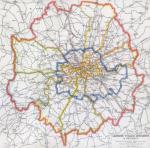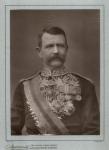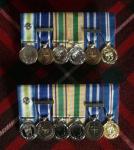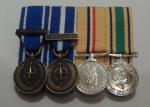-
Posts
3,517 -
Joined
-
Last visited
-
Days Won
27
Content Type
Profiles
Forums
Blogs
Gallery
Events
Store
Everything posted by bigjarofwasps
-
Ladies/Gents, Please forgive me ignorance, but can anyone answer a few questions for me with regards to Divisional areas, on the below map.. 1. What does the blue online mean? 2. Why do some of the other Divisions have a yellow outer boarder and some don't? 3. H & G Divisions seem so small and yet J Division appears huge and also appears to include a large area of the East End, but only seems to have slightly more officers that H & G, why is that? Given it's size why was it called Bethnal Green which is only a tiny part of it? G or Finsbury Division. King's Cross Road. Charles Hunt, Supt.; Inspectors 23; Sergeants 46; Constables 480. Total 550. H or Whitechapel Division. Leman Street. Thos. Arnold, Supt.; Inspectors 30; Sergeants 44; Constables 473. Total 548. J or Bethnal Green Division. Bethnal Green Road. James Keating, Supt.; Inspectors 38; Sergeants 56; Constables 522. Total 617.
-
Ladies/Gents, Can anyone advise me on how Met Police posting worked between 1886 & 1891. I have a medal to a bobby who joined up in 1886 and was posted to C Div. In 1888 he was posted to J Division, then in 1890 he was posted E Division. I know he was married and had three children by 1891. Would this have any bearing on his postings. All the Divisions are relatively close together, but J Division appears to have been huge in those days. Is it possible that he could have been posted somewhere like Chigwell or is it more likely that he would have been kept more centre, given his other postings? I also note that he had two collar numbers whilst in J Division 223J/502J would this give any indication as to where in J Division he was stationed (or indeed his other collar numbers whilst stationed at different Divisions)? Finally why did they call J Division Bethnal Green Division, when it did in fact cover an area far removed from Bethnal Green? Was it normal practice for a married officer to be moved round so often in such a short space of time? Gordon.
-
Police Constable Joseph Daniels Metropolitan Police Joined 17th May 1886, posted to C Div PC 387 (St James), 10th August 1888, posted to J Div PC 223/PC 502 (Bethnal Green) 20 days before the murder of Polly Nichols, at Bucks Row. 15th August 1890 posted to E Div PC259 (Holborn). He received a pay increase on the 23rd May 1891. Then on the 23rd May 1892, he died on duty, from choking to death on his own false teeth, whilst effecting an arrest. A local paper, The Holborn and Finsbury Guardian ran the following story. The Danger of False Teeth On Wednesday evening at St Clement Danes Vestry-hall, Strand, Mr John Troutbeck, the coroner for Westminster, held an inquiry into the circumstances attending the death of Police Constable Joseph Daniels 259E aged 27 years who was killed early on Sunday morning whilst taking a prisoner to Bow Street Police Station. Superintendent Steggles of the E Division, was present, Joseph Daniels a registration agent of 9 Meeting House Lane, Peckham. Identified the deceased as his son, lately resided at Jubilee Buildings, Waterloo Road. Sometime ago he had erysipelas in the face, and the divisional surgeon ordered him to have some of his teeth extracted and replaced by false ones. These he was wearing at the time of his death, PC 379E Alfred Smith, said that on Sunday morning at about 12:20 he was in Kemble Street, Clare market, taking a prisoner to Bow Street Police Station. A crowd of several hundred persons had assembled and an attempt to rescue the man was made. Witness blew his whistle and in response the deceased came running up. He took hold of the prisoners other arm and they had only proceeded a few yards, when the witness missed the deceased, and on looking round saw him lying on the pavement. Another constable came up and witness went oh his way. PC350E William Stewart said that he was on duty in Newcastle Street when he heard the whistle blow, and on going to Kemble Street saw the two Constables with a man in custody. Witness broke through the crowd, and then he saw the deceased lying on the ground. He immediately undid his collar and sent for an ambulance, on which he conveyed the unfortunate man to the hospital. By the Coroner: the deceased was not knocked down, kicked or otherwise assaulted. Dr Eric Law Pritchard, house physician at Kings College Hospital, said that the deceased was dead when he was admitted. He made the post-mortem examination, which revealed that the deceased, was an exceedingly healthy man. Just about the larynx witness found a set of false teeth impacted, which had produced suffocation, the cause of death. The teeth were of a very inferior make, no doubt they became loosened through the deceased running, and an inspiration drew them down his throat. The jury returned a verdict of ?Accidental Death? and added that they thought the deceased was over anxious to do his duty. Warrant No.- 71719; collar no.- 259 E Div; Pension to wife and 3 children - "died from the effects of an injury received in the execution of his duty" - 'swallowed false teeth when going to assist in arrest of a prisoner'; Death Register ref. - June 1892-St Giles 1b 377 age 27; died 22nd May His widow, Louisa was given a job cleaning the police station at Bow Street and the pension enabled her to educate the 2 boys Albert and William and her daughter Florence .William grew up and became a police officer in Brighton.
-
METROPOLITAN POLICE CONSTABLE 135.H CHARLEY SMITH WHITECHAPEL DIVISION WARRANT NO: 72728 SERVED 27/06/1887 - 01/07/1912 1897 METROPOLITAN POLICE JUBILEE MEDAL: PC. C. SMITH. H. DIV 1902 METROPOLITAN POLICE CORONATION MEDAL: PC. C. SMITH. H. DIV 1911 METROPOLITAN POLICE CORONATION MEDAL: PC. C. SMITH 14903 CHARLEY SMITH was born on 07/03/1865 in Hannington, Northamptonshire, having worked as an agricultural worker he joined the Metropolitan Police on 27/06/1887 with the warrant number: 72728. He was posted to their H Division (Whitechapel), given the uniform collar number: 135.H, and was stationed at H Division's Commercial Street Police Station. Whilst living in quarters there he appears on the census and electoral rolls between 1891-1895. Having joined Whitechapel Division the year prior to the 'Jack the Ripper' killings he would have certainly been personally involved in the hunt for The Ripper on his normal patrols, and extra duties, expecially as he was showing an interest in a future with the Criminal Investigations Department (CID) through the period of the killings. Who knows, maybe seeing Abberline and his men at work helped decide Charley's future career path onto the Whitechapel CID. On 30/01/1888 Charley gave his first evidence at The Old Bailey Court, after chasing and arresting a burglar in Spelman Street, Whitechapel. He went on to give evidence at The Old Bailey on a staggering 21 seperate occassions, his cases ranged from burglary, theft, robbery, extortion, counterfeit currency, and receiving stolen goods. Every crime had been committed within the 1, 1/4 mile square of Whitechapel, and many of them within the infamous Whitechapel Public Houses. On 08/10/1894 Charley was promoted to rank of Detective Constable onto the Whitechapel CID, and was stationed at the Divisional HQ at Leman Street. Once there he would have been one of only 7 Detective Constables, who worked under the direction of a Detective Inspector and 8 Detective Sergeants. On 22/04/1898 Charley married in Northamptonshire, and he and his new wife moved into 20 Walden Street, Mile End Old Town, (Just off the Whitechapel Road). On 16/12/1901 Charley was Highly Commended by the Judge at The Old Bailey Court for his part in arresting 3 dangerous members of a notorious London criminal gang, who were wanted for many crimes all over London. He was commended alongside his Detective Inspector, Frederick Wensley, and his Detective Sergeant, Benjamin Leeson, both of which were later to be shot during the SIEGE OF SIDNEY STREET. On 3rd January 1911 the famous siege of Sidney Street commenced, after police attended at 100 Sidney Street to arrest members of a gang wanted for the murder of 3 City of London police officers the month before. Divisional Detective Inspector Frederick Wensley of H Division CID knocked on the front door whilst accompanied by a number of Whitechapel Detectives (Including Detective Sergeant Benjamin Leeson) during the siege both of these Detectives from Whitechapel CID received gunshot wounds. As Charley was a long serving and respected Detective of the same CID office, had worked very closely with Wensley and Leeson, and was living only 3 roads away from Sidney Street, I have no doubt Charley would have been in Wensley's team of Detectives who approached the front of 100 Sidney Street, and went on to be involved in the infamous seige. Charley Smith served his entire career of 25 years and 4 days with the Metropolitan Police on their Whitechapel Division, and 18 years of which was on it's CID. It is very rare to find medals to a man who stayed on the same Division for his entire career, especially as that Division was the famous 'H' which was involved in so many high profile cases during his time of service. Charley resigned from the service on 01/07/1912 to an annual pension of £56,12,4. He moved with his wife back to his birth place of Hannington in Northamptonshire, and stayed there until his death on 13/09/1945 (aged 80 years). Charley's full size original group of medals are now framed alongside a matching original trio of minatures, against a backing of a detailed street map of Whitechapel, London, dated 1888. (He was 7 days short of receiving the 1887 Jubilee medal, as he joined on 27th June 1887, and the Jubilee took place on the 21st!, so his group was almost a trio with 1897 bar!) 1897 medal was issued as a Uniformed Constable on H Division (One of 287) 1902 medal was issued as a Detective Constable on H Division (One of only 9) 1911 medal was issued as a Detective Constable on H Division (One of approx 12)
-
The officers directly involved in the Whitechapel murders are all well documented, as I'm sure you'll agree. I thought it might be interesting and of benefit to collectors with an interest in the Whitechapel murders if a database of medals known to exist could be put together, that were issued to officers that can be confirmed as having been present in the area, whether that be by already serving in the area at the time or posted in to bolster officer numbers.
-
I entirely agree. It will be very interesting to see if these coins ever come into existence. I'm not convinced that they'll be anything more than an historical oddity for collectors to be honest. I hear that Gaddafi was planning the same sort of thing just before NATO bombed the country to bits......
-

Iraq medal x2?
bigjarofwasps replied to bigjarofwasps's topic in Great Britain: Orders, Gallantry, Campaign Medals
This appears to be another example (again miniatures), South Atlantic Medal and Iraq Reconstruction Medal? This would certainly suggest military and then civilian service? Not convinced the ISAF NATO medal would be awarded to a civilian though? -

Iraq medal x2?
bigjarofwasps replied to bigjarofwasps's topic in Great Britain: Orders, Gallantry, Campaign Medals
Many thanks for all your replies guys. I am assuming that the Iraq Campaign medal was awarded for a tour with HM Armed Forces and the other medal is for service as a UK Police Officer perhaps? As the two would be separate entities then maybe two medals could be worn? This does appear to be a miniature set, should the full size group exist then I assume the second Iraq medal would be named? But in this example could both medals be worn? I suppose technically as there for separate roles, you could in fact wear both? -
Having just watched a documentary on Channel 5 about a new Jack the Ripper suspect, (Charles Allen Lechmere). I was pleasantly surprised as to how much information had been uncovered about this seemingly obscure individual. This rekindled my interest in the subject and hence looking for my old post about PC Daniels. Can anyone tell me whether it was usual back in the day for Bobbies to live on the same manor that they policed? If so I wonder would it be possible to ascertain what his address was? Has anyone got any experience of this sort of thing? Cheryl, if your still a visitor to the forum I'd very much like to speak to you about your relative, gutted that I missed the opportunity last year. That'll teach me to visit the site more regularly!!
-
Ladies/Gents, Am curious to know whether this medal group is genuine or not? Is it possible to have qualified for both of these Iraq medals. I assume that the recipient must have been in the military for one and a civilian for the other? Is this possible or would qualification for the first mean exclusion from qualifying for the second?
-
Islamic-era copper coins discovered in Shahrekord – Islamic-era copper coins have been discovered in west-central Iran province of Chaharmahal and Bakhtiari. The discovery of the coins indicate using the coins had been prevalent still in periods as early as Seljukid and Ilkhanid eras during Islamic period, state news agency IRNA reported. Cultural Heritage Organization Research House expert Mitra Shateri, who is also head of the first season of archeological explorations in historical Ribat site, said the second season was launched in last October in an ancient hilltop to ‘find insight to the physical remains of the site.’ “An area of 400 square meters the ruins of the monument including chambers and halls which belonged to a greater structure of 100 square meters were uncovered,” said Shateri. “In past years, the operations to dredging of the local qanat system had rendered part of the structure in ruins; recent explorations has bring out of the soil part of a public building complex used as caravanserai or a ribat with special plan consisting of stone foundations, remains of brick walls, kilns and stone storehouses interspersed among the architectural spaces,” she explained. Shateri also said that Islamic period copper coins, simple glazed pottery items had been uncovered, which she believed was indication that the building complex traced back to Seljukid and Ilkhanid periods and found use as cemetery in later centuries. “Explorations in the site is an important step to discover and document the remains of caravanserais and to retrieve caravan routes and connecting roads in Islamic and pre-Islamic period in the west-central Iran through finding specific types of plans of caravanserais in Zagros mounts,” asserted the head of archeological expedition. “The site has potentials for designation as a cultural complex for tourism which would also include a green space for camping in addition to a museum which would host the site’s historical objets trouvés,” she proposed. Ribat historical site is located 15 km east of Shahrekord on the historical route connecting Isfahan with Khuzestan, now in the modern highway connecting Shahrekord to Isfahan. According to sources, it goes back to about 1000 years ago.
-
And coin collectors in the U.S., take note: Owning one of the new gold coins would put you in legally dubious territory. “Legally speaking you’d have a pretty good case that’s transacting in ISIL currency would be prohibited as engaging in transactions in which a designating terrorist organization has a controlling interest,” said Mr. Poncy.










